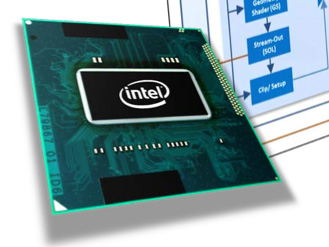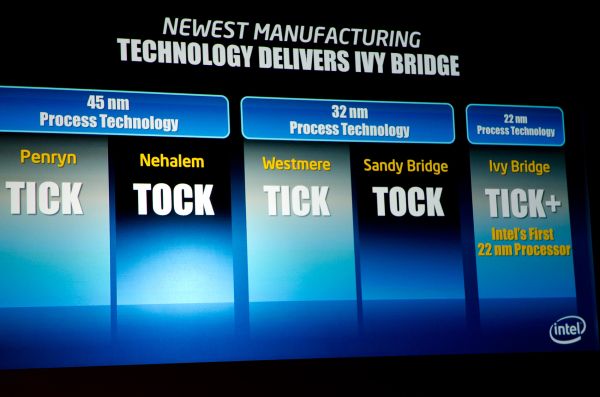The Ivy Bridge Preview: Core i7 3770K Tested
by Anand Lal Shimpi on March 6, 2012 8:16 PM EST- Posted in
- CPUs
- Intel
- Core i7
- Ivy Bridge
Note: This preview was not sanctioned or supported by Intel in any way.
I still remember hearing about Intel's tick-tock cadence and not having much faith that the company could pull it off. Granted Intel hasn't given us a new chip every 12 months on the dot, but more or less there's something new every year. Every year we either get a new architecture on an established process node (tock), or a derivative architecture on a new process node (tick). The table below summarizes what we've seen since Intel adopted the strategy:
| Intel's Tick-Tock Cadence | |||||
| Microarchitecture | Process Node | Tick or Tock | Release Year | ||
| Conroe/Merom | 65nm | Tock | 2006 | ||
| Penryn | 45nm | Tick | 2007 | ||
| Nehalem | 45nm | Tock | 2008 | ||
| Westmere | 32nm | Tick | 2010 | ||
| Sandy Bridge | 32nm | Tock | 2011 | ||
| Ivy Bridge | 22nm | Tick | 2012 | ||
| Haswell | 22nm | Tock | 2013 | ||
Last year was a big one. Sandy Bridge brought a Conroe-like increase in performance across the board thanks to a massive re-plumbing of Intel's out-of-order execution engine and other significant changes to the microarchitecture. If you remember Conroe (the first Core 2 architecture), what followed it was a relatively mild upgrade called Penryn that gave you a little bit in the way of performance and dropped power consumption at the same time.

Ivy Bridge, the tick that follows Sandy Bridge, would typically be just that: a mild upgrade that inched performance ahead while dropping power consumption. Intel's microprocessor ticks are usually very conservative on the architecture side, which limits the performance improvement. Being less risky on the architecture allows Intel to focus more on working out the kinks in its next process node, in turn delivering some amount of tangible power reduction.
Where Ivy Bridge shakes things up is on the graphics side. For years Intel has been able to ship substandard graphics in its chipsets based on the principle that only gamers needed real GPUs and Windows ran just fine on integrated graphics. Over the past decade that philosophy required adjustment. First it was HD video decode acceleration, then GPU accelerated user interfaces and, more recently, GPU computing applications. Intel eventually committed to taking GPU performance (and driver quality) seriously, setting out on a path to significantly improve its GPUs.
As Ivy is a tick in Intel's cadence, we shouldn't see much of a performance improvement. On the CPU side that's mostly true. You can expect a 5 - 15% increase in performance for the same price as a Sandy Bridge CPU today. A continued desire to be aggressive on the GPU front however puts Intel in a tough spot. Moving to a new manufacturing process, especially one as dramatically different as Intel's 22nm 3D tri-gate node isn't easy. Any additional complexity outside of the new process simply puts schedule at risk. That being said, its GPUs continue to lag significantly behind AMD and more importantly, they still aren't fast enough by customer standards.
Apple has been pushing Intel for faster graphics for years, having no issues with including discrete GPUs across its lineup or even prioritizing GPU over CPU upgrades. Intel's exclusivity agreement with Apple expired around Nehalem, meaning every design win can easily be lost if the fit isn't right.
With Haswell, Intel will finally deliver what Apple and other customers have been asking for on the GPU front. Until then Intel had to do something to move performance forward. A simple tick wouldn't cut it.

Intel calls Ivy Bridge a tick+. While CPU performance steps forward, GPU performance sees a more significant improvement - in the 20 - 50% range. The magnitude of improvement on the GPU side is more consistent with what you'd expect from a tock. The combination of a CPU tick and a GPU tock is how Intel arrives at the tick+ naming. I'm personally curious to see how this unfolds going forward. Will GPU and CPUs go through alternating tocks or will Intel try to synchronize them? Do we see innovation on one side slow down as the other increases? Does tick-tock remain on a two year cadence now that there are two fairly different architectures that need updating? These are questions I don't know that we'll see answers to until after Haswell. For now, let's focus on Ivy Bridge.










195 Comments
View All Comments
tipoo - Wednesday, March 7, 2012 - link
Thankfully the comments of a certain troll were removed so mine no longer makes sense, for any future readers.Articuno - Tuesday, March 6, 2012 - link
Just like how overclocking a Pentium 4 resulted in it beating an Athlon 64 and had lower power consumption to boot-- oh wait.SteelCity1981 - Tuesday, March 6, 2012 - link
That's a stupid comment only a stupid fanboy would make AMD is way ahead of Intel in the graphics department and is very competitive with Intel in the mobile segment now.tipoo - Tuesday, March 6, 2012 - link
Your comments would do nothing to inform regular readers of sites like this, we already know more. So please, can it.tipoo - Tuesday, March 6, 2012 - link
Not what I asked little troll. Give a source that says Apple will get a special HD4000 like no other.Operandi - Tuesday, March 6, 2012 - link
What are you talking about? As long as AMD has a better iGPU there is plenty of reason for them to be viable choice today. And if gaming iGPU performance holds on against Intel there is more than just hope of them getting back in the game in terms of high performance comput tomorrow.tipoo - Tuesday, March 6, 2012 - link
I'm pretty sure even 16x AF has a sub 2% performance hit on even the lowest end of todays GPUs, is it different with the HD Graphics? If not, why not just enable it like most people would, even on something like a 4670 I max out AF without thinking twice about it, AA still hurts performance though.IntelUser2000 - Tuesday, March 6, 2012 - link
AF has greater performance impact on low end GPUs. Typically its about 10-15%. It's less on the HD Graphics 3000, only because their 16x AF really only works at much lower levels. It's akin to having option for 1280x1024 resolution, but performing like 1024x768 because it looks like the latter.If Ivy Bridge improved AF quality to be on par with AMD/Nvidia, performance loss should be similar as well.
tipoo - Wednesday, March 7, 2012 - link
Hmm I did not know that, what component of the GPU is involved in that performance hit (shaders, ROPs, etc)? My card is fairly low end and 16x AF performs nearly no different than 0x.Exophase - Wednesday, March 7, 2012 - link
AF requires more samples in cases of high anisotropy so I guess the TMU load increases, which may also increase bandwidth requirements since it could force higher LOD in these cases. You'll only see a performance difference if the AF causes the scene to be TMU/bandwidth limited instead of say, ALU limited. I'd expect this to happen more as you move up in performance, not down, since ALU:TEX ratio tends to go up along the higher end.. but APUs can be more bandwidth sensitive and I think Intel's IGPs never had a lot of TMUs.Of course it's also very scene dependent. And maybe an inferior AF implementation could end up sampling more than a better one.